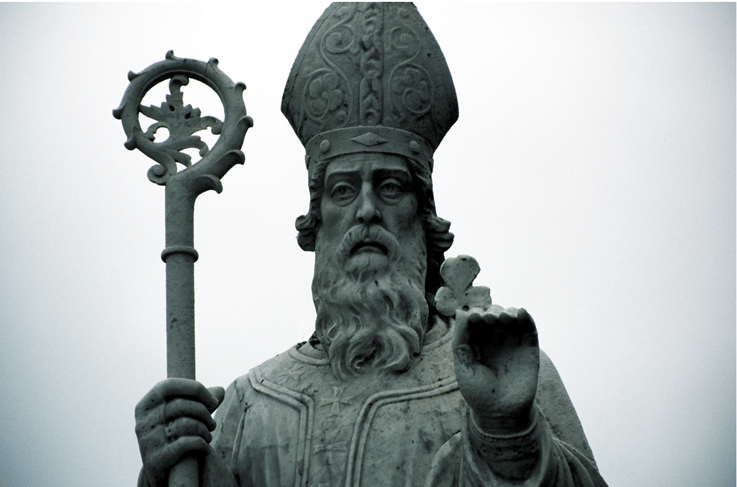 Much of what is known about St. Patrick's life has been interwoven with folklore and legend. Historians generally believe that St. Patrick (his real name was Maewyn Succat), the patron saint of Ireland, was born in Britain (not Ireland) near the end of the 4th century.
Much of what is known about St. Patrick's life has been interwoven with folklore and legend. Historians generally believe that St. Patrick (his real name was Maewyn Succat), the patron saint of Ireland, was born in Britain (not Ireland) near the end of the 4th century.
At age 16, he was kidnapped and sold as a slave to a Celtic priest in Northern Ireland. After toiling for six years as a shepherd, he escaped back to Britain. He eventually returned to Ireland as a Christian missionary. By the time of his death on March 17, 461 (the day we celebrate is not his birthday but the day he died), he had established monasteries, churches, and schools. Irish emigrants to the United States transformed St. Patrick's Day into a largely secular holiday of revelry and celebration of all things Irish.
6 Myths and Legends Surrounding St. Patrick
1. Snakes, What Snakes?
Among the legends most associated with St. Patrick is that he banished snakes from Ireland—prompting all serpents to slither away into the sea. In fact, snakes never occupied the Emerald Isle.
2. The Legend of the Shamrock
The shamrock, a three-leaf clover, has been associated with Ireland for centuries. It was considered a sacred plant that symbolized the arrival of spring. Many believe that St. Patrick used the three-leaf clover to teach others about the Christian Holy Trinity (the Father, the Son, and the Holy Spirit), but that has yet to be proven true. However, the number three was sacred in Irish mythology, so it does make sense for the shamrock to hold a high place in Irish folklore.
3. The first St. Patrick's Day Parade was held in America, not Ireland.
While people in Ireland have celebrated St. Patrick since the 1600s, the tradition of a St. Patrick's Day parade began in America and predates the founding of the United States.
Records show that a St. Patrick's Day parade was held on March 17, 1601, in a Spanish colony in St. Augustine, Florida. Enthusiasm for the St. Patrick's Day parades in New York City, Boston, and other early American cities grew from there. Today, according to Metro NY, approximately 150,000 people participate in the New York City parade annually, and around 2 million people come out to watch.
4. The Traditional Meal: Ham and Cabbage?
The meal that became a St. Patrick's Day staple across the country—corned beef and cabbage—was an American innovation. Irish Americans living in the slums of lower Manhattan in the late 19th century and early 20th purchased leftover corned beef from ships returning from the tea trade in China. While ham and cabbage were eaten in Ireland, corned beef offered a cheaper substitute for impoverished immigrants in America.
5. The Wearing of the Blue?
Blue was the color most associated with St.Patrick, and green was considered unlucky. Blue is still regarded as symbolic of Ireland — so how did green become the go-to color for those who don't want to get pinched?
Historically, green has been the color linked to a series of Irish rebellions that took place to gain independence from the English crown. The color stuck once waves of Irish immigrants made their home in America and began wearing green and carrying the Irish flag to show their pride for their home country.
Since 1962 Chicago has colored its river green to mark the holiday. Irish and non-Irish alike commonly participate in the "wearing of the green," sporting an item of green clothing or a shamrock, the Irish national plant, in their lapel. Although some of these practices were eventually adopted by the Irish themselves, they did so mainly for the benefit of tourists.
6. Have you ever seen a lady leprechaun?
No? That's because they don't exist. There has been no record of female leprechauns, and what's more, leprechauns are considered part of the fairy family. Some have even said that leprechauns are rejected fairies who have been ousted by the fairy community. This explains why they're usually described as grouchy creatures prone to mischief.
Since 2005, Quikstone Capital Solutions has helped thousands of merchants with cash for all their business needs. Our process is easy, fast, and flexible.
At Quikstone, we want you to succeed. For help with your business needs, contact us today!





